What We’re Reading: March 17
Review: Methods of cell-specific hormone analysis ($)
 Plant hormones are active at very small quantities and often act differently in different cell types. Various methods, primarily involving mass spectrometry and sensors, have been developed to identify and quantify hormones with cellular-level precision. Novák et al. review these methods and discuss their strengths and limitations, as well as future perspectives in “hormonomics”. Annu. Rev. Plant Biol. 10.1146/annurev-arplant-042916-040812 Tags: Cell Biology, Molecular Biology, Signals and Responses
Plant hormones are active at very small quantities and often act differently in different cell types. Various methods, primarily involving mass spectrometry and sensors, have been developed to identify and quantify hormones with cellular-level precision. Novák et al. review these methods and discuss their strengths and limitations, as well as future perspectives in “hormonomics”. Annu. Rev. Plant Biol. 10.1146/annurev-arplant-042916-040812 Tags: Cell Biology, Molecular Biology, Signals and Responses
Review: Progeny responses to maternal vs progeny environmental cues
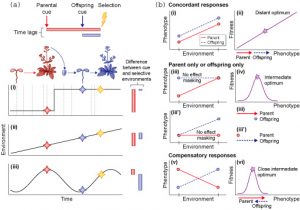 The range of responses an individual could display is a contribution of the inheritance of gene variants that determine such responses and the environments experienced by the individual itself and prior generations (nongenetic inheritance). In this review, we discuss recent empirical data to help us understand how the same cues experienced across and within generations (nongenetic information) contribute to progeny phenotypes and adaptation to changing environments. The predictive ability of parental and offspring environments is discussed relative to the costs of expressing a certain phenotype in the progeny, and the conflicts of responding to cues experienced by the different generations. Understanding the adaptive value of transgenerational effects seems relevant in face of the actual climate change projections. (Summary by Gaby Auge) New Phytol. DOI: 10.1111/nph.14495 Tags: Abiotic Interactions, Genetics, Growth Regulation
The range of responses an individual could display is a contribution of the inheritance of gene variants that determine such responses and the environments experienced by the individual itself and prior generations (nongenetic inheritance). In this review, we discuss recent empirical data to help us understand how the same cues experienced across and within generations (nongenetic information) contribute to progeny phenotypes and adaptation to changing environments. The predictive ability of parental and offspring environments is discussed relative to the costs of expressing a certain phenotype in the progeny, and the conflicts of responding to cues experienced by the different generations. Understanding the adaptive value of transgenerational effects seems relevant in face of the actual climate change projections. (Summary by Gaby Auge) New Phytol. DOI: 10.1111/nph.14495 Tags: Abiotic Interactions, Genetics, Growth Regulation
Review: Plant sex determination
 Most angiosperms are hermaphrodites and produce flowers that have both male (stamens / sperm) and female (carpels / egg) parts. Pannell reviews the developmental and genetic programs that lead to these “perfect” flowers, as well as those that underlie reproductive structure development in dioecious and monoecious species. His analysis further extends to bryophytes and vascular non-seed plants. He describes sex determination in plants as fundamentally a quantitative and plastic trait, with a key conclusion that “separate sexes tend to have evolved independently in different lineages, and much more recently than in most animal lineages.” Curr. Biol. 10.1016/j.cub.2017.01.05 Tags: Botany, Evolution
Most angiosperms are hermaphrodites and produce flowers that have both male (stamens / sperm) and female (carpels / egg) parts. Pannell reviews the developmental and genetic programs that lead to these “perfect” flowers, as well as those that underlie reproductive structure development in dioecious and monoecious species. His analysis further extends to bryophytes and vascular non-seed plants. He describes sex determination in plants as fundamentally a quantitative and plastic trait, with a key conclusion that “separate sexes tend to have evolved independently in different lineages, and much more recently than in most animal lineages.” Curr. Biol. 10.1016/j.cub.2017.01.05 Tags: Botany, Evolution
Review: Using mustard genomes to explore the genetic basis of evolutionary change ($)
 Brassicaceae is one of the largest angiosperm families and provides many opportunities for studies of evolution. Of course, its most famous species, Arabidopsis thaliana is an important resource, but Brassicaceae also includes the very interesting Brassica crops (cabbage, turnip) that demonstrate the power of selection. Nikolov and Tsiantis provide a thorough overview of this plant family, its evolutionary trajectories, and the contributions of genome and gene duplication in trait diversification. Curr. Opin. Plant Biol. 10.1016/j.pbi.2017.02.005 Tags: Botany, Development, Evolution, Genomics
Brassicaceae is one of the largest angiosperm families and provides many opportunities for studies of evolution. Of course, its most famous species, Arabidopsis thaliana is an important resource, but Brassicaceae also includes the very interesting Brassica crops (cabbage, turnip) that demonstrate the power of selection. Nikolov and Tsiantis provide a thorough overview of this plant family, its evolutionary trajectories, and the contributions of genome and gene duplication in trait diversification. Curr. Opin. Plant Biol. 10.1016/j.pbi.2017.02.005 Tags: Botany, Development, Evolution, Genomics
Review: Receptor kinases in plant pathogen interactions: More than pattern recognition
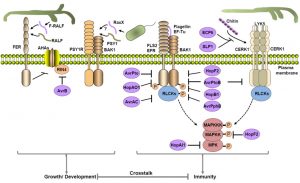 Zhou et al. review the contributions of Receptor-Like Kinases (RLKs) and Receptor-Like Proteins (RLPs) as Pattern Recognition Receptors (PRRs) that contribute to the recognition of pathogens, as well as the contributions of receptor-like cytoplasmic kinases (RLCKs). The authors summarize recent studies that show how complex formation by PRRs affects their activities, and how PRR complexes and RLCKs differentially regulate downstream signals. Finally, the authors summarize the many ways that pathogens subvert the recognition and elicitation of defense responses. Plant Cell 10.1105/tpc.16.00891 Tags: Biotic Interactions, Signals and Responess
Zhou et al. review the contributions of Receptor-Like Kinases (RLKs) and Receptor-Like Proteins (RLPs) as Pattern Recognition Receptors (PRRs) that contribute to the recognition of pathogens, as well as the contributions of receptor-like cytoplasmic kinases (RLCKs). The authors summarize recent studies that show how complex formation by PRRs affects their activities, and how PRR complexes and RLCKs differentially regulate downstream signals. Finally, the authors summarize the many ways that pathogens subvert the recognition and elicitation of defense responses. Plant Cell 10.1105/tpc.16.00891 Tags: Biotic Interactions, Signals and Responess
Review: Quantitative resistance: More than just perception of a pathogen
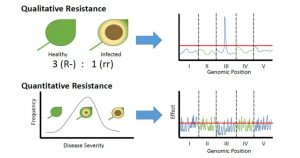 Some forms of pathogen resistance function like an on/off switch: if a plant has an appropriate receptor it recognizes a pathogen and shows resistance. Corwin and Kliebenstein review the other kind of resistance, quantitative resistance, in which many genes make small contributions to the plant’s resistance. These quantitative resistance loci are lesser known and more difficult to study, but nevertheless govern the outcome of the majority of plant-pathogen interactions. The authors review some of the molecular players involved in quantitative resitance and also describe the genetic and genomic tools that are helping to shed light on the mechanisms of quantitative resistance. Plant Cell 10.1105/tpc.16.00915 Tags: Biotic Interactions, Genetics
Some forms of pathogen resistance function like an on/off switch: if a plant has an appropriate receptor it recognizes a pathogen and shows resistance. Corwin and Kliebenstein review the other kind of resistance, quantitative resistance, in which many genes make small contributions to the plant’s resistance. These quantitative resistance loci are lesser known and more difficult to study, but nevertheless govern the outcome of the majority of plant-pathogen interactions. The authors review some of the molecular players involved in quantitative resitance and also describe the genetic and genomic tools that are helping to shed light on the mechanisms of quantitative resistance. Plant Cell 10.1105/tpc.16.00915 Tags: Biotic Interactions, Genetics
Method: Microphenotron, a miniaturized robotic phenotyping platform
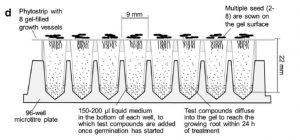 High-throughput screening greatly extends the number of individuals that can be screened, so is particularly crucial for genetic or chemical genetic approaches. Burrell et al. report on a miniaturized robotic phenotyping platform, “Microphenotron” designed for chemical genetic screening. Seeds are planted in phytostrips, small tubes with flat sides for improved imaging. This platform allows the effects of chemical compounds (more than 4000 treatments at a time) to be assessed by repeated imaging of the root and shoot system. Plant Methods 10.1186/s13007-017-0158-6 Tags: Genetics, Growth Regulation, Molecular Biology
High-throughput screening greatly extends the number of individuals that can be screened, so is particularly crucial for genetic or chemical genetic approaches. Burrell et al. report on a miniaturized robotic phenotyping platform, “Microphenotron” designed for chemical genetic screening. Seeds are planted in phytostrips, small tubes with flat sides for improved imaging. This platform allows the effects of chemical compounds (more than 4000 treatments at a time) to be assessed by repeated imaging of the root and shoot system. Plant Methods 10.1186/s13007-017-0158-6 Tags: Genetics, Growth Regulation, Molecular Biology
Spotlight: The fate of the world’s plants ($)
 In 2016, Kew Gardens released a report “The State of the World’s Plants”, which includes estimates of the total number of plant species on Earth and the percentage of those facing extinction. Pimm and Raven delve into those numbers and offer the opinion that many species will be lost before they are even discovered. They observe that it is relatively easy to preserve plant germplasm and that we should “push as hard as we can to discover missing species and preserve them. For some, it may be their last days in nature”. (Interested in more? The 2017 State of the World’s Plants symposium is in May). Trends Ecol. Evol. 10.1016/j.tree.2017.02.014 Tags: Environmental Plant Biology
In 2016, Kew Gardens released a report “The State of the World’s Plants”, which includes estimates of the total number of plant species on Earth and the percentage of those facing extinction. Pimm and Raven delve into those numbers and offer the opinion that many species will be lost before they are even discovered. They observe that it is relatively easy to preserve plant germplasm and that we should “push as hard as we can to discover missing species and preserve them. For some, it may be their last days in nature”. (Interested in more? The 2017 State of the World’s Plants symposium is in May). Trends Ecol. Evol. 10.1016/j.tree.2017.02.014 Tags: Environmental Plant Biology
Dual role of the histone variant H2A.Z in regulation of stress-response genes
 Histones are protein complexes around which genomic DNA is wrapped; post-translational modifications to histone proteins and alterations of histone protein composition affect transcription. H2A.Z is a widely conserved variant form of histone H2A that has been implicated in various forms of transcriptional regulation. Sura et al. examine the role of H2A.Z in the Arabidopsis stress response by investigating the occupancy patterns of H2A.Z and the transcriptional responses of the arp6 mutant, which is impaired in H2A.Z deposition. The authors found that H2A.Z in the gene body represses transcription of many stress-inducible genes, but that in other genes H2A.Z in the first nucleosome downstream of the transcription start site (the +1 nucleosome) is positively correlated with transcription. Thus, H2A.Z has a dual role in transcriptional regulation. Plant Cell 10.1105/tpc.16.00573 Tags: Abiotic Interactions, Gene Regulation, Molecular Biology
Histones are protein complexes around which genomic DNA is wrapped; post-translational modifications to histone proteins and alterations of histone protein composition affect transcription. H2A.Z is a widely conserved variant form of histone H2A that has been implicated in various forms of transcriptional regulation. Sura et al. examine the role of H2A.Z in the Arabidopsis stress response by investigating the occupancy patterns of H2A.Z and the transcriptional responses of the arp6 mutant, which is impaired in H2A.Z deposition. The authors found that H2A.Z in the gene body represses transcription of many stress-inducible genes, but that in other genes H2A.Z in the first nucleosome downstream of the transcription start site (the +1 nucleosome) is positively correlated with transcription. Thus, H2A.Z has a dual role in transcriptional regulation. Plant Cell 10.1105/tpc.16.00573 Tags: Abiotic Interactions, Gene Regulation, Molecular Biology
Origin and evolution of transporter substrate specificity within the NPF family
 Which arose first during evolution- a metabolite molecule or a transporter that could move it across a membrane? Jørgensen et al. studied transporters for glucosinolate defense molecules in Brassicales species. Glucosinolates are derived from the broad class of cyanogenic glucosides, and glucosinolates are transported by GTR H+/glucosinolate symporters of the NPF transporter family. Phylogenetic analysis of NPF transporter sequences showed a subclade of GTR-like transporters in C. papaya, the most basal glucosinolate-producing species, and Brassicales species that do not produce glucosinolates, including cassava. When expressed in Xenopus oocytes, a novel transporter gene from cassava showed broad specificity for glucosinolates and cyanogenic glucosides, suggesting this is an evolutionary intermediate for NPF transporters and indicating that the ability to transport glucosinolates occurs in a species that does not produce them. Testing the specificity of C. papaya transporters for glucosinolates and cyanogenic glucosides allowed the authors to imply that preference for specific glucosinolates evolved from transporters that were originally broadly-specific for glucosinolates. So, a transporter that can move a metabolite has evolved prior to the appearance of the molecule which can be transported. (Summary by Daniel Czerny) eLIFE 10.7554/eLife.19466 Tags: Evolution, Transport
Which arose first during evolution- a metabolite molecule or a transporter that could move it across a membrane? Jørgensen et al. studied transporters for glucosinolate defense molecules in Brassicales species. Glucosinolates are derived from the broad class of cyanogenic glucosides, and glucosinolates are transported by GTR H+/glucosinolate symporters of the NPF transporter family. Phylogenetic analysis of NPF transporter sequences showed a subclade of GTR-like transporters in C. papaya, the most basal glucosinolate-producing species, and Brassicales species that do not produce glucosinolates, including cassava. When expressed in Xenopus oocytes, a novel transporter gene from cassava showed broad specificity for glucosinolates and cyanogenic glucosides, suggesting this is an evolutionary intermediate for NPF transporters and indicating that the ability to transport glucosinolates occurs in a species that does not produce them. Testing the specificity of C. papaya transporters for glucosinolates and cyanogenic glucosides allowed the authors to imply that preference for specific glucosinolates evolved from transporters that were originally broadly-specific for glucosinolates. So, a transporter that can move a metabolite has evolved prior to the appearance of the molecule which can be transported. (Summary by Daniel Czerny) eLIFE 10.7554/eLife.19466 Tags: Evolution, Transport
IRREGULAR POLLEN EXINE1 Is a novel factor in anther cuticle and pollen exine formation
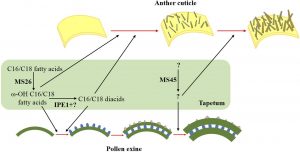 Chen et al. identified a novel male-sterile Zea mays mutant, named ipe1. Mutant pollen grains show defective development of the tapetum and pollen exine (outer surface), causing microspore abortion. In addition, ipe1 anthers are smooth instead of reticulate, suggesting defects in anther cuticle formation. IPE1 expression is specific to the tapetum and developmentally restricted to the early uninucleate microspore stage. GC-MS analysis of anther wax and cutin content revealed that ipe1 anthers have reduced cutin monomer content relative to wild type. RNA sequencing showed over 3,000 differentially-expressed genes in ipe1, including genes involved in biosynthesis or degradation of lipids, carbohydrates, and waxes. A T-DNA mutant of the Arabidopsis IPE1 homolog shows normal anther cuticle development, but mature pollen grains have partial smooth surfaces, as in the maize mutant. The authors present a model for IPE1 functioning in anther lipid metabolism. (Summary by Daniel Czerny) Plant Physiol. 10.1104/pp.16.00629 Tags: Genetics, Metabolism
Chen et al. identified a novel male-sterile Zea mays mutant, named ipe1. Mutant pollen grains show defective development of the tapetum and pollen exine (outer surface), causing microspore abortion. In addition, ipe1 anthers are smooth instead of reticulate, suggesting defects in anther cuticle formation. IPE1 expression is specific to the tapetum and developmentally restricted to the early uninucleate microspore stage. GC-MS analysis of anther wax and cutin content revealed that ipe1 anthers have reduced cutin monomer content relative to wild type. RNA sequencing showed over 3,000 differentially-expressed genes in ipe1, including genes involved in biosynthesis or degradation of lipids, carbohydrates, and waxes. A T-DNA mutant of the Arabidopsis IPE1 homolog shows normal anther cuticle development, but mature pollen grains have partial smooth surfaces, as in the maize mutant. The authors present a model for IPE1 functioning in anther lipid metabolism. (Summary by Daniel Czerny) Plant Physiol. 10.1104/pp.16.00629 Tags: Genetics, Metabolism
Plant immune and growth receptors share common signaling components but localize to distinct plasma membrane nanodomains
 Signal transduction in plant and animal cells is often initiated at the plasma membrane (PM) and involves common signaling components, raising the question of how receptor complexes elicit distinct signaling outputs. To address this question, Bücherl et al. investigated physical characteristics of the transmembrane plant immune receptor FLS2 and growth receptor BRI1. Using imaging techniques including live-cell imaging, single-particle tracking and quantitative co-localization analysis of leaf epidermal cells, the authors demonstrated that FLS2 and BRI1 receptors exhibit distinct spatial localization patterns within distinct PM clusters and exhibit different dynamics (steady-state FLS2 is more stable and less mobile than BRI1). This observation, coupled to the observation that only BRI1-containing complexes were associated with cortical microtubules, led the authors to conclude that spatio-temporal separation exists between immune and growth receptor-mediated signaling, a phenomena that is also observed in animal cells. This spatio-temporal separation may provide signaling specificity due to differential receptor localization and protein complex composition. The unique biochemical environments of the receptors may provide a mechanism for regulating intermolecular interactions and for adjusting signal transduction. Next steps include ascertaining whether the spatio-temporal separation of receptor complexes affects the phosphorylation of downstream shared signaling components and elucidating the stoichiometry of the unique PM signaling clusters. (Summary by Tyra McCray) eLIFE 10.7554/eLife.25114. Tags: Biotic Interactions, Growth Regulation, Signals and Responses
Signal transduction in plant and animal cells is often initiated at the plasma membrane (PM) and involves common signaling components, raising the question of how receptor complexes elicit distinct signaling outputs. To address this question, Bücherl et al. investigated physical characteristics of the transmembrane plant immune receptor FLS2 and growth receptor BRI1. Using imaging techniques including live-cell imaging, single-particle tracking and quantitative co-localization analysis of leaf epidermal cells, the authors demonstrated that FLS2 and BRI1 receptors exhibit distinct spatial localization patterns within distinct PM clusters and exhibit different dynamics (steady-state FLS2 is more stable and less mobile than BRI1). This observation, coupled to the observation that only BRI1-containing complexes were associated with cortical microtubules, led the authors to conclude that spatio-temporal separation exists between immune and growth receptor-mediated signaling, a phenomena that is also observed in animal cells. This spatio-temporal separation may provide signaling specificity due to differential receptor localization and protein complex composition. The unique biochemical environments of the receptors may provide a mechanism for regulating intermolecular interactions and for adjusting signal transduction. Next steps include ascertaining whether the spatio-temporal separation of receptor complexes affects the phosphorylation of downstream shared signaling components and elucidating the stoichiometry of the unique PM signaling clusters. (Summary by Tyra McCray) eLIFE 10.7554/eLife.25114. Tags: Biotic Interactions, Growth Regulation, Signals and Responses
Temperature induced remodeling of the photosynthetic machinery tunes photosynthesis in a thermophyllic red alga ($)
 The red alga Cyanidioschyzon merolae is notable for several reasons: it is an early-branching red alga, it has one of the smallest genomes and simplest cellular structures of photosynthetic eukaryotes, and its photosynthetic machinery is intermediate between cyanobacteria and green algae. Furthermore, it thrives at high temperatures. Nikolova et al. examined how acclimation to lower temperatures (25°C versus 42°C) affected C. merolae photosynthetic processes and proteome. After an acclimation period of about ten days, the growth rate of cells growing at a lower temperature roughly matched those growing at the higher temperature. Key findings include the fact that the photosynthetic machinery was extensively remodelled at 25°C, with a reduction in antenna-complex and photosystem proteins, leading to these cells requiring 2.5x more light to reach maximum photosynthetic efficiency. Plant Physiol. 10.1104/pp.17.00110 Tags: Bioenergetics, Botany
The red alga Cyanidioschyzon merolae is notable for several reasons: it is an early-branching red alga, it has one of the smallest genomes and simplest cellular structures of photosynthetic eukaryotes, and its photosynthetic machinery is intermediate between cyanobacteria and green algae. Furthermore, it thrives at high temperatures. Nikolova et al. examined how acclimation to lower temperatures (25°C versus 42°C) affected C. merolae photosynthetic processes and proteome. After an acclimation period of about ten days, the growth rate of cells growing at a lower temperature roughly matched those growing at the higher temperature. Key findings include the fact that the photosynthetic machinery was extensively remodelled at 25°C, with a reduction in antenna-complex and photosystem proteins, leading to these cells requiring 2.5x more light to reach maximum photosynthetic efficiency. Plant Physiol. 10.1104/pp.17.00110 Tags: Bioenergetics, Botany
Regulation of gravitropic set point angle
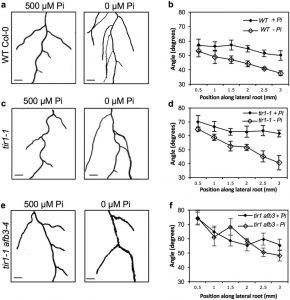 One parameter that defines a plant’s architecture is the angle at which its branches and lateral roots lie with respect to gravity, known as the gravitropic set point angle (GSA). Like all aspects of plant architecture, GSA is a highly plastic trait that is sensitive to light and nutrient availability. Roychoudhry et al. show that these effects on GSA are mediated by auxin levels or sensitivity. Key findings include opposite effects of low N and low P on lateral root GSA, and differences in the way that adventitious roots and lateral roots respond to nutrient deficiencies. Sci. Rep. 10.1038/srep42664 Tags: Ecophysiology, Growth Regulation, Signals and Responses
One parameter that defines a plant’s architecture is the angle at which its branches and lateral roots lie with respect to gravity, known as the gravitropic set point angle (GSA). Like all aspects of plant architecture, GSA is a highly plastic trait that is sensitive to light and nutrient availability. Roychoudhry et al. show that these effects on GSA are mediated by auxin levels or sensitivity. Key findings include opposite effects of low N and low P on lateral root GSA, and differences in the way that adventitious roots and lateral roots respond to nutrient deficiencies. Sci. Rep. 10.1038/srep42664 Tags: Ecophysiology, Growth Regulation, Signals and Responses
Divergence of annuality and perenniality in Brassicaceae and contribution of FLC variation ($)
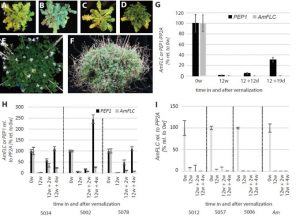 FLOWERING LOCUS C (FLC) is a flowering repressor that is highly conserved in the Brassicaceae family. This family contains species that show an annual life history (plants that flower and senesce, giving one generation per year), as well as perennials (plants that flower several times in their life cycle and don’t senesce after producing the next generation). Kiefer et al. studied the divergence of annuals and perennials in this family. They confirmed perenniality is the ancestral state with annuality evolving independently in several lineages. They found several FLC orthologues in the species they studied but no correlation between the complexity of those orthologues (gene and intron duplication, deletions or insertions) and life history. However, they show that the FLC orthologues set a vernalization requirement in almost all the species that were studied (except in one, Arabis purpurea). Moreover, expression of the FLC orthologues also corresponds with the expected pattern before, during and after vernalization in annuals and perennials. The genetic basis of this difference is analyzed in hybrids and sequence variation and the authors show that two regions with variation might be responsible to confer stable repression or reactivation of FLC after vernalization in annuals and perennials respectively. (Summary by Gaby Auge) Mol.Ecol. 10.1111/mec.14084 Tags: Botany, Ecophysiology, Growth Regulation
FLOWERING LOCUS C (FLC) is a flowering repressor that is highly conserved in the Brassicaceae family. This family contains species that show an annual life history (plants that flower and senesce, giving one generation per year), as well as perennials (plants that flower several times in their life cycle and don’t senesce after producing the next generation). Kiefer et al. studied the divergence of annuals and perennials in this family. They confirmed perenniality is the ancestral state with annuality evolving independently in several lineages. They found several FLC orthologues in the species they studied but no correlation between the complexity of those orthologues (gene and intron duplication, deletions or insertions) and life history. However, they show that the FLC orthologues set a vernalization requirement in almost all the species that were studied (except in one, Arabis purpurea). Moreover, expression of the FLC orthologues also corresponds with the expected pattern before, during and after vernalization in annuals and perennials. The genetic basis of this difference is analyzed in hybrids and sequence variation and the authors show that two regions with variation might be responsible to confer stable repression or reactivation of FLC after vernalization in annuals and perennials respectively. (Summary by Gaby Auge) Mol.Ecol. 10.1111/mec.14084 Tags: Botany, Ecophysiology, Growth Regulation
The rice paradox: Multiple origins but single domestication in Asian rice
 Rice is the world’s most important food crop and its domestication was a key event in human history. Centuries of propagation across large geographical areas have resulted in five domesticated subpopulations: aus, indica, temperate japonica, tropical japonica, and aromatic rice. Choi et al. analyzed de novo assembled genomes from domesticated rice and its wild progenitors. Their analysis indicates that although different rice subspecies had different origins, domestication occurred only once. Introgression of domestication genes from japonica to aus and indica led to their domestication, which is consistent with archeological evidence. Mol. Evol. 10.1093/molbev/msx049 Tags: Botany, Evolution, Genomics
Rice is the world’s most important food crop and its domestication was a key event in human history. Centuries of propagation across large geographical areas have resulted in five domesticated subpopulations: aus, indica, temperate japonica, tropical japonica, and aromatic rice. Choi et al. analyzed de novo assembled genomes from domesticated rice and its wild progenitors. Their analysis indicates that although different rice subspecies had different origins, domestication occurred only once. Introgression of domestication genes from japonica to aus and indica led to their domestication, which is consistent with archeological evidence. Mol. Evol. 10.1093/molbev/msx049 Tags: Botany, Evolution, Genomics
Autocrine regulation of stomatal differentiation potential by EPF1 and ERECTA-LIKE1 ligand-receptor signaling
 The patterning of stomata in epidermal tissues involves both positive and negative cues, as revealed by the phenotypes of mutants including too many mouths and speechless, but the precise interactions between identified gene products are still not fully resolved. Qi et al. explore the interactions between SPEECHLESS (SPCH) and MUTE, transcription factors, EPIDERMAL PATTERNING FACTOR2 (EPF2), a small secreted peptide, and a set of membrane receptors including TOO MANY MOUTHS (TMM), EPIDERMAL PATTERNING FACTOR1 (EPF1) and EPF2, and ERECTA and ERECTA-LIKE1 (ERL1). Key findings include that ERL1 is a MUTE-induced gene, and that EPF1-ERL1 signaling pathway inhibits MUTE. The authors propose a model in which the co-presence of EPF1, ERL1, and MUTE inhibits stomatal fate, and argue that EPF1 acts as an autocrine signal. eLIFE 10.7554/eLife.24102 Tags: Development, Gene Regulation
The patterning of stomata in epidermal tissues involves both positive and negative cues, as revealed by the phenotypes of mutants including too many mouths and speechless, but the precise interactions between identified gene products are still not fully resolved. Qi et al. explore the interactions between SPEECHLESS (SPCH) and MUTE, transcription factors, EPIDERMAL PATTERNING FACTOR2 (EPF2), a small secreted peptide, and a set of membrane receptors including TOO MANY MOUTHS (TMM), EPIDERMAL PATTERNING FACTOR1 (EPF1) and EPF2, and ERECTA and ERECTA-LIKE1 (ERL1). Key findings include that ERL1 is a MUTE-induced gene, and that EPF1-ERL1 signaling pathway inhibits MUTE. The authors propose a model in which the co-presence of EPF1, ERL1, and MUTE inhibits stomatal fate, and argue that EPF1 acts as an autocrine signal. eLIFE 10.7554/eLife.24102 Tags: Development, Gene Regulation
A phenol-enriched cuticle is ancestral to lignin evolution in land plants
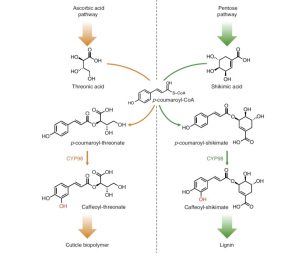 Moss are non-vascular plants and do not produce the phenolic polymer lignin, but they do have some enzymes associated with the lignin pathway, raising the question of the evolutionary origins of lignin. In angiosperms, the cytochrome P450 enzyme encoded by CYP98 catalyzes the first irreversible step in monolignol (a lignin subunit) formation. Renault et al. showed that the moss CYP98 gene is critical for cuticle formation, an extracellular polymer required for desiccation tolerance. This result suggests that the “lipid–phenolic matrix present in P. patens may constitute an extant representative of the common ancestor of the suberin, cutin and lignin polymers” that was presumably critical for the transition of plants to land. Nature Comm. 10.1038/ncomms14713 Tags: Botany, Evolution, Metabolism
Moss are non-vascular plants and do not produce the phenolic polymer lignin, but they do have some enzymes associated with the lignin pathway, raising the question of the evolutionary origins of lignin. In angiosperms, the cytochrome P450 enzyme encoded by CYP98 catalyzes the first irreversible step in monolignol (a lignin subunit) formation. Renault et al. showed that the moss CYP98 gene is critical for cuticle formation, an extracellular polymer required for desiccation tolerance. This result suggests that the “lipid–phenolic matrix present in P. patens may constitute an extant representative of the common ancestor of the suberin, cutin and lignin polymers” that was presumably critical for the transition of plants to land. Nature Comm. 10.1038/ncomms14713 Tags: Botany, Evolution, Metabolism
Elevated CO2 does not increase eucalypt forest productivity on low-phosphorus soil ($)
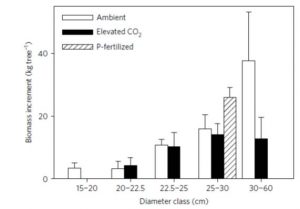 The “Law of the Minimum” put forth by Justus von Liebig states that the most limiting nutrient governs plant growth. Although there is evidence in some conditions that increasing atmospheric CO2 levels can enhance plant growth, this only holds true under conditions in which CO2 is limiting growth. Ellsworth et al. found no productivity gains in mature eucalypt forest growing on phosphate-poor soils when CO2 levels were raised. When phosphate fertilizer was added and so growth was no longer P- limited, they observed a growth enhancement with elevated CO2. These results demonstrate the need to consider the availability of soil nutrients when forecasting plant responses to elevated CO2. Nature Climate Change 10.1038/nclimate3235 Tags: Ecophysiology, Environmental Plant Biology
The “Law of the Minimum” put forth by Justus von Liebig states that the most limiting nutrient governs plant growth. Although there is evidence in some conditions that increasing atmospheric CO2 levels can enhance plant growth, this only holds true under conditions in which CO2 is limiting growth. Ellsworth et al. found no productivity gains in mature eucalypt forest growing on phosphate-poor soils when CO2 levels were raised. When phosphate fertilizer was added and so growth was no longer P- limited, they observed a growth enhancement with elevated CO2. These results demonstrate the need to consider the availability of soil nutrients when forecasting plant responses to elevated CO2. Nature Climate Change 10.1038/nclimate3235 Tags: Ecophysiology, Environmental Plant Biology
The contribution of solar brightening to the US maize yield trend ($)
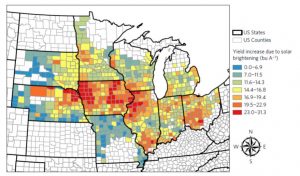 Over the past several decades, the amount of maize produced in the US Midwestern “Corn Belt” has been rising steadily. In order to accurately predict future grain yields, the factors that contribute to these recent yield increases must be identified. Tollenaar et al. found that more than a quarter (27%) of recent US maize yield increases are a consequence of “solar brightening” – an increase in the amount of light reaching the Earth’s surface in these growing regions. Solar brightening and dimming are affected by clouds but also by air quality. In other parts of the world, declining air quality has led to solar dimming. The authors argue that the beneficial impacts on grain yield should be considered when calculating the costs associated with efforts to protect air quality, and also that the effect of solar brightening is not likely to continue to increase, making the case that genetic sources of yield improvement will be even more important for future yield increases. Nature Climate Change 10.1038/nclimate3234 Tags: Environmental Plant Biology
Over the past several decades, the amount of maize produced in the US Midwestern “Corn Belt” has been rising steadily. In order to accurately predict future grain yields, the factors that contribute to these recent yield increases must be identified. Tollenaar et al. found that more than a quarter (27%) of recent US maize yield increases are a consequence of “solar brightening” – an increase in the amount of light reaching the Earth’s surface in these growing regions. Solar brightening and dimming are affected by clouds but also by air quality. In other parts of the world, declining air quality has led to solar dimming. The authors argue that the beneficial impacts on grain yield should be considered when calculating the costs associated with efforts to protect air quality, and also that the effect of solar brightening is not likely to continue to increase, making the case that genetic sources of yield improvement will be even more important for future yield increases. Nature Climate Change 10.1038/nclimate3234 Tags: Environmental Plant Biology


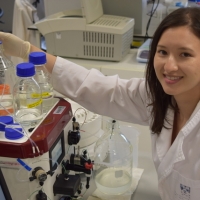 A 60-year-old mystery has been solved by biochemists at The University of Western Australia investigating the origin of a type of digestion-inhibiting proteins thought only to exist in two plant families that contain the important legume and cereal crops.
A 60-year-old mystery has been solved by biochemists at The University of Western Australia investigating the origin of a type of digestion-inhibiting proteins thought only to exist in two plant families that contain the important legume and cereal crops. This Update focuses on the starch that accumulates in the guard cells that control stomatal pore size and thus the exchange of water vapor, CO2 and O2 between the leaf and the atmosphere. Transitory starch in these cells plays a key role in determining the velocity of stomatal opening in the light. This significantly differs from the transitory starch in the mesophyll leaves, which acts primarily as a carbohydrate reserve to sustain plant metabolism during the night. We discuss how the unique function of transitory starch in guard cells is reflected in the timing of its deposition and mobilization, along with differences from mesophyll cells in the pathways and regulation of starch metabolism.
This Update focuses on the starch that accumulates in the guard cells that control stomatal pore size and thus the exchange of water vapor, CO2 and O2 between the leaf and the atmosphere. Transitory starch in these cells plays a key role in determining the velocity of stomatal opening in the light. This significantly differs from the transitory starch in the mesophyll leaves, which acts primarily as a carbohydrate reserve to sustain plant metabolism during the night. We discuss how the unique function of transitory starch in guard cells is reflected in the timing of its deposition and mobilization, along with differences from mesophyll cells in the pathways and regulation of starch metabolism.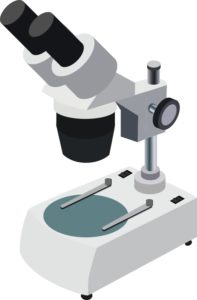
 Most-read rankings are recalculated at the beginning of the month and are based on full-text and pdf views.
Most-read rankings are recalculated at the beginning of the month and are based on full-text and pdf views. Plants have evolved a variety of mechanisms to synchronize flowering with their environment to optimize reproductive success. Many species flower in spring when the photoperiod increases and the ambient temperatures become warmer. Winter annuals and biennials have evolved repression mechanisms that prevent the transition to reproductive development in the fall. These repressive processes can be overcome by the prolonged cold of winter through a process known as vernalization. The memory of the past winter is sometimes stored by epigenetic chromatin remodeling processes that provide competence to flower, and plants usually require additional inductive signals to flower in spring. The requirement for vernalization is widespread within groups of plants adapted to temperate climates; however, the genetic and biochemical frameworks controlling the response are distinct in different groups of plants, suggesting independent evolutionary origins. Here, we compare and contrast the vernalization pathways in different families of plants.
Plants have evolved a variety of mechanisms to synchronize flowering with their environment to optimize reproductive success. Many species flower in spring when the photoperiod increases and the ambient temperatures become warmer. Winter annuals and biennials have evolved repression mechanisms that prevent the transition to reproductive development in the fall. These repressive processes can be overcome by the prolonged cold of winter through a process known as vernalization. The memory of the past winter is sometimes stored by epigenetic chromatin remodeling processes that provide competence to flower, and plants usually require additional inductive signals to flower in spring. The requirement for vernalization is widespread within groups of plants adapted to temperate climates; however, the genetic and biochemical frameworks controlling the response are distinct in different groups of plants, suggesting independent evolutionary origins. Here, we compare and contrast the vernalization pathways in different families of plants.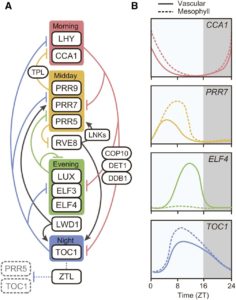 Plants sense changes in day length (= photoperiod) as a reliable seasonal cue to regulate important developmental transitions such as flowering. Integration of various external light information into the circadian clock-controlled mechanisms enables plants to precisely measure photoperiod changes in the surrounding environment. The core mechanism of photoperiodic measurement is regulation of CONSTANS (CO) activity, which takes place in phloem companion cells in leaves. Until recently, it remained unclear whether plants possess specific variations of the clock for this regulation. Now it is known that a specific circadian timing mechanism in the vascular tissue is essential for photoperiodic flowering. In addition to spatial tissue-specific regulation, temporal regulation of CO activity is also important. The identification and characterization of multiple regulators that physically interact with CO and influence its function in the morning in long days are two recent advances in photoperiodic regulation of flowering time. It seems that CO acts as a network hub to integrate various external and internal signals into the photoperiodic flowering pathway. CO regulates the amount of FLOWERING LOCUS T (FT) transcripts and FT protein moves from companion cells of leaf phloem to the shoot apical meristem. The protein that helps long-distance transport of FT protein was also identified recently. Here, we introduce recent advances in tissue-specific variations of the circadian clock and the emerging picture of the intricate connections of transcriptional regulators through CO in the morning, which all facilitate plants knowing when to flower.
Plants sense changes in day length (= photoperiod) as a reliable seasonal cue to regulate important developmental transitions such as flowering. Integration of various external light information into the circadian clock-controlled mechanisms enables plants to precisely measure photoperiod changes in the surrounding environment. The core mechanism of photoperiodic measurement is regulation of CONSTANS (CO) activity, which takes place in phloem companion cells in leaves. Until recently, it remained unclear whether plants possess specific variations of the clock for this regulation. Now it is known that a specific circadian timing mechanism in the vascular tissue is essential for photoperiodic flowering. In addition to spatial tissue-specific regulation, temporal regulation of CO activity is also important. The identification and characterization of multiple regulators that physically interact with CO and influence its function in the morning in long days are two recent advances in photoperiodic regulation of flowering time. It seems that CO acts as a network hub to integrate various external and internal signals into the photoperiodic flowering pathway. CO regulates the amount of FLOWERING LOCUS T (FT) transcripts and FT protein moves from companion cells of leaf phloem to the shoot apical meristem. The protein that helps long-distance transport of FT protein was also identified recently. Here, we introduce recent advances in tissue-specific variations of the circadian clock and the emerging picture of the intricate connections of transcriptional regulators through CO in the morning, which all facilitate plants knowing when to flower.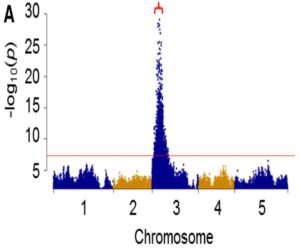 Biogeographic studies suggest that the degree of fatty acid unsaturation in oilseeds has played a major role in adapting plants to temperature. The enzymes that are primarily responsible for producing polyunsaturated fatty acids in seed oils are the microsomal ω-6 and ω-3 fatty acid desaturases FAD2 and FAD3, which act in sequence to convert oleic acid (18:1) to linoleic acid (18:2) and then to α-linolenic acid (18:3), while the fatty acid is esterified to the sn-2 position of phosphatidylcholine. Temperature can influence the degree of microsomal fatty acid desaturation indirectly through its effects on substrate availability. However, there also is evidence that FAD2 and FAD3 are regulated directly by temperature. Whether this regulation occurs at the level of gene expression appears to vary depending upon the species, tissue, and gene in question. Many previous studies have exploited genetic approaches to investigate the function of fatty acid desaturation in plant temperature adaptation. However, no studies appear to have used genetic variation in plants to study the underlying regulatory mechanisms.
Biogeographic studies suggest that the degree of fatty acid unsaturation in oilseeds has played a major role in adapting plants to temperature. The enzymes that are primarily responsible for producing polyunsaturated fatty acids in seed oils are the microsomal ω-6 and ω-3 fatty acid desaturases FAD2 and FAD3, which act in sequence to convert oleic acid (18:1) to linoleic acid (18:2) and then to α-linolenic acid (18:3), while the fatty acid is esterified to the sn-2 position of phosphatidylcholine. Temperature can influence the degree of microsomal fatty acid desaturation indirectly through its effects on substrate availability. However, there also is evidence that FAD2 and FAD3 are regulated directly by temperature. Whether this regulation occurs at the level of gene expression appears to vary depending upon the species, tissue, and gene in question. Many previous studies have exploited genetic approaches to investigate the function of fatty acid desaturation in plant temperature adaptation. However, no studies appear to have used genetic variation in plants to study the underlying regulatory mechanisms. 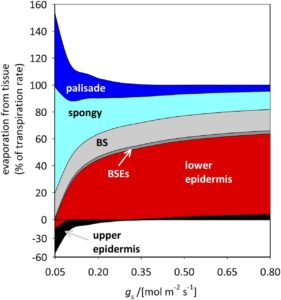 Current available evidence suggests that the location of the sites of evaporation is important for many questions across plant physiology, including patterns of leaf isotopic enrichment, maintenance of mesophyll water status, stomatal regulation, and interpretation of measured stomatal and leaf hydraulic conductances. To resolve these questions, Buckley et al. (pp.
Current available evidence suggests that the location of the sites of evaporation is important for many questions across plant physiology, including patterns of leaf isotopic enrichment, maintenance of mesophyll water status, stomatal regulation, and interpretation of measured stomatal and leaf hydraulic conductances. To resolve these questions, Buckley et al. (pp.